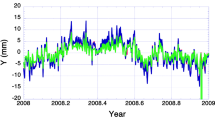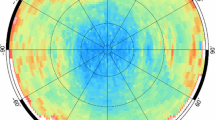Abstract
The Earth’s non-spherical mass distribution and atmospheric drag cause the strongest perturbations on very low-Earth orbiting satellites (LEOs). Models of gravitational and non-gravitational accelerations are utilized in dynamic precise orbit determination (POD) with GPS data, but it is also possible to derive LEO positions based on GPS precise point positioning without dynamical information. We use the reduced-dynamic technique for LEO POD, which combines the geometric strength of the GPS observations with the force models, and investigate the performance of different pseudo-stochastic orbit parametrizations, such as instantaneous velocity changes (pulses), piecewise constant accelerations, and continuous piecewise linear accelerations. The estimation of such empirical orbit parameters in a standard least-squares adjustment process of GPS observations, together with other relevant parameters, strives for the highest precision in the computation of LEO trajectories. We used the procedures for the CHAMP satellite and found that the orbits may be validated by means of independent SLR measurements at the level of 3.2 cm RMS. Validations with independent accelerometer data revealed correlations at the level of 95% in the along-track direction. As expected, the empirical parameters compensate to a certain extent for deficiencies in the dynamic models. We analyzed the capability of pseudo-stochastic parameters for deriving information about the mismodeled part of the force field and found evidence that the resulting orbits may be used to recover force field parameters, if the number of pseudo-stochastic parameters is large enough. Results based on simulations showed a significantly better performance of acceleration-based orbits for gravity field recovery than for pulse-based orbits, with a quality comparable to a direct estimation if unconstrained accelerations are set up every 30 s.
Similar content being viewed by others
References
Bertiger WI, Bar-Sever YE, Christensen EJ, Davis ES, Guinn JR, Haines BJ, Ibanez-Meier RW, Jee JR, Lichten SM, Melbourne WG, Muellerschoen RJ, Munson TN, Vigue Y, Wu SC, Yunck TP, Schutz BE, Abusali PAM, Rim HJ, Watkins MM, Willis P (1994) GPS precise tracking of TOPEX/POSEIDON: results and implication. J Geophys Res 99(C12):24449–24464
Beutler G, Brockmann E, Gurtner W, Hugentobler U, Mervart L, Rothacher M (1994) Extended orbit modeling techniques at the CODE processing center of the international GPS service for geodynamics (IGS): theory and initial results. Manuscripta Geodetica 19:367–386
Beutler G (2004) Methods of celestial mechanics. Springer, Berlin Heidelberg New York
Bock H, Hugentobler U, Springer TA, Beutler G (2002) Efficient precise orbit determination of LEO satellites using GPS. Adv Space Res 30(2):295–300
Boomkamp H (2003) The CHAMP orbit comparison campaign. In: Reigber C, Lühr H, Schwintzer P (eds) First CHAMP mission results for gravity, magnetic and atmospheric studies. Springer, Berlin Heidelberg New York, pp 53–58
CSR ocean tide model from Schwiderski (1995) ftp://ftp.csr.utexas.edu/pub/tide/oldfiles/spharm_schwid+
Eanes RJ, Bettadpur SV (1995) The CSR 3.0 global ocean tide model. Technical Memorandum 95-06, Center for Space Research University of Texas, Austin
European Space Agency ESA (1999) The Four Candidate Earth Explorer Core Missions: Gravity Field and Steady-State Ocean Circulation Mission. ESA SP-1233 (1)
Földváry L, Švehla D, Gerlach C, Wermuth M, Gruber T, Rummel R, Rothacher M, Frommknecht B, Peters T, Steigenberger P (2004) Gravity model TUM-2Sp based on the energy balance approach and kinematic CHAMP orbits. In: Reigber C, Lühr H, Schwintzer P, Wickert J (eds) Earth observation with CHAMP, results from three years in orbit. Springer, Berlin Heidelberg New York, pp 13–18
Fu L, Christensen EJ, Yamarone CA, Lefebvre M, Ménard Y, Dorrer M, Escudier P (1994) TOPEX/POSEIDON mission overview. J Geophys Res 99(C12):24369–24381
Gerlach C, Földváry L, Švehla D, Gruber T, Wermuth M, Sneeuw N, Frommknecht B, Oberndorfer H, Peters T, Rothacher M, Rummel R, Steigenberger P (2003) A CHAMP-only gravity field model from kinematic orbits using the energy integral. Geophys Res Lett 30(20):2037 DOI 10.1029/2003GL018025
Hugentobler U, Schaer S, Fridez P (2001) Bernese GPS Software Version 4.2. Documentation. Astronomical Institute University of Berne, Berne
van den IJssel J, Visser PNAM, Patiño Rodriguez E (2003) CHAMP precise orbit determination using GPS data. Adv Space Res 31(8):1889–1895
van den IJssel J, Visser PNAM (2005) Determination of non-conservative accelerations from GPS satellite-to-satellite tracking of CHAMP. Adv Space Res 36(3):418–423
Jäggi A, Beutler G, Hugentobler U (2004a) Efficient stochastic orbit modeling techniques using least squares estimators. In: Sansò F (eds) A window on the future of geodesy. Springer, Berlin Heidelberg New York, pp 175–180
Jäggi A, Bock H, Hugentobler U, Beutler G (2004b) Comparison of different stochastic orbit modeling techniques. In: Reigber C, Lühr H, Schwintzer P, Wickert J (eds) Earth observation with CHAMP, results from three years in orbit. Springer, Berlin Heidelberg New York, pp 89–94
Jäggi A, Beutler G, Hugentobler U (2005) Reduced-dynamic orbit determination and the use of accelerometer data. Adv Space Res 36(3):438–444
Jazwinski AH (1970) Stochastic processes and filtering theories. Academic, New York
König R, Michalak G, Neumayer KH, Schmidt R, Zhu SY, Meixner H, Reigber C (2004) Recent developments in CHAMP orbit determination at GFZ. In: Reigber C, Lühr H, Schwintzer P, Wickert J (eds) Earth observation with CHAMP, results from three years in orbit. Springer, Berlin Heidelberg New York, pp 65–70
Kursinski ER, Hajj GA, Schofield JT, Linfield RP, Hardy KR (1997) Observing Earth’s atmosphere with radio occultation measurements using the Global Positioning System. J Geophys Res 102(D19):23429–23465
Mayer-Gürr T, Ilk KH, Eicker A, Feuchtinger M (2004) ITG-CHAMP01: a CHAMP gravity field model from short kinematical arcs of a one-year observation period. J Geod 78:462–480
O’Keefe JA (1957) An application of Jacobi’s integral to the motion of an Earth satellite. Astron J 62(1252):265–266
Reigber C (1989) Gravity field recovery from satellite tracking data. In: Sansò F, Rummel R (eds) Theory of satellite geodesy and gravity field determination. Springer, Berlin Heidelberg New York, pp 197–234
Reigber C, Balmino G, Schwintzer P, Biancale R, Bode A, Lemoine JM, Koenig R, Loyer S, Neumayer H, Marty JC, Barthelmes F, Perosanz F, Zhu SY (2002) A high quality global gravity field model from CHAMP GPS tracking data and accelerometry (EIGEN-1S). Geophys Res Lett 29(14):37–1 DOI 10.1029/2002GL015064
Reigber C, Schwintzer P, Neumayer KH, Barthelmes F, König R, Förste C, Balmino G, Biancale R, Lemoine JM, Loyer S, Bruinsma S, Perosanz F, Fayard T (2003) The CHAMP-only Earth Gravity Field Model EIGEN-2. Adv Space Res 31(8):1883–1888
Reigber C, Jochmann H, Wünsch J, Petrovic S, Schwintzer P, Barthelmes F, Neumayer KH, König R, Förste C, Balmino G, Biancale R, Lemoine JM, Loyer S, Perosanz F (2004) Earth gravity field and seasonal variability from CHAMP. In: Reigber C, Lühr H, Schwintzer P, Wickert J (eds) Earth observation with CHAMP, results from three years in orbit. Springer, Berlin Heidelberg New York, pp 89–94
Švehla D, Rothacher M (2002) Kinematic and reduced-dynamic precise orbit determination of low Earth orbiters. Adv Geosci 1:47–56
Švehla D, Rothacher M (2004) Kinematic precise orbit determination for gravity field determination. In: Sansò F (eds) A window on the future of geodesy. Springer, Berlin Heidelberg New York, pp 181–188
Touboul P, Willemenot E, Foulon B, Josselin V (1999) Accelerometers for CHAMP, GRACE and GOCE space missions: synergy and evolution. Boll Geof Teor Appl 40:321–327
Visser PNAM, van den IJssel J (2003a) Aiming at a 1-cm orbit for low Earth orbiters: reduced-dynamic and kinematic precise orbit determination. In: Beutler G, Rummel R, Drinkwater MR, von Steiger R (eds) Earth gravity field from space - from sensors to Earth sciences. Kluwer, Dordrecht, pp 27–36
Visser PNAM, Sneeuw N, Gerlach C (2003b) Energy integral method for gravity field determination from satellite orbit coordinates. J Geod 77:207–216
Wu SC, Yunck TP, Thornton CL (1991) Reduced-dynamic technique for precise orbit determination of low Earth satellites. J Guid Control Dyn 14(1):24–30
Author information
Authors and Affiliations
Corresponding author
Rights and permissions
About this article
Cite this article
Jäggi, A., Hugentobler, U. & Beutler, G. Pseudo-Stochastic Orbit Modeling Techniques for Low-Earth Orbiters. J Geodesy 80, 47–60 (2006). https://doi.org/10.1007/s00190-006-0029-9
Received:
Accepted:
Published:
Issue Date:
DOI: https://doi.org/10.1007/s00190-006-0029-9




